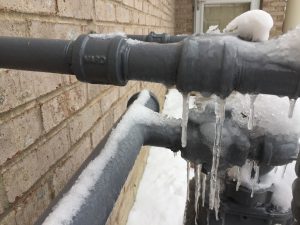Just about everyone has got their own piece of advice involving 6 Ways to Prevent Frozen Pipes.

Cold weather can ruin your plumbing, especially by freezing pipelines. Here's how to prevent it from taking place and what to do if it does.
Introduction
As temperatures drop, the threat of frozen pipes boosts, potentially resulting in costly repairs and water damages. Comprehending how to stop icy pipes is essential for homeowners in cool climates.
Avoidance Tips
Protecting vulnerable pipelines
Cover pipelines in insulation sleeves or utilize heat tape to secure them from freezing temperatures. Focus on pipelines in unheated or exterior locations of the home.
Home heating strategies
Keep interior rooms sufficiently warmed, especially areas with pipes. Open up closet doors to allow warm air to flow around pipelines under sinks.
How to identify frozen pipes
Try to find lowered water circulation from taps, unusual odors or sounds from pipelines, and noticeable frost on subjected pipes.
Long-Term Solutions
Structural modifications
Think about rerouting pipes far from outside wall surfaces or unheated locations. Add added insulation to attic rooms, basements, and crawl spaces.
Updating insulation
Purchase top quality insulation for pipelines, attic rooms, and walls. Correct insulation assists maintain regular temperatures and reduces the danger of frozen pipes.
Safeguarding Outdoor Pipes
Yard hose pipes and outside faucets
Disconnect and drain pipes yard hose pipes prior to winter. Set up frost-proof faucets or cover outdoor faucets with shielded caps.
Understanding Frozen Pipelines
What creates pipes to freeze?
Pipes ice up when revealed to temperatures below 32 ° F (0 ° C) for prolonged durations. As water inside the pipelines ices up, it expands, taxing the pipeline wall surfaces and possibly creating them to burst.
Risks and damages
Frozen pipes can result in water disruptions, home damage, and pricey repair services. Ruptured pipes can flood homes and cause extensive architectural damages.
Indications of Frozen Pipes
Identifying icy pipes early can prevent them from bursting.
What to Do If Your Pipelines Freeze
Immediate activities to take
If you think icy pipelines, keep taps available to relieve stress as the ice melts. Make use of a hairdryer or towels soaked in warm water to thaw pipes slowly.
Verdict
Stopping frozen pipes calls for positive actions and quick feedbacks. By comprehending the reasons, signs, and safety nets, home owners can shield their plumbing throughout winter.
5 Ways to Prevent Frozen Pipes
Drain Outdoor Faucets and Disconnect Hoses
First, close the shut-off valve that controls the flow of water in the pipe to your outdoor faucet. Then, head outside to disconnect and drain your hose and open the outdoor faucet to allow the water to completely drain out of the line. Turn off the faucet when done. Finally, head back to the shut-off valve and drain the remaining water inside the pipe into a bucket or container. Additionally, if you have a home irrigation system, you should consider hiring an expert to clear the system of water each year.
Insulate Pipes
One of the best and most cost-effective methods for preventing frozen water pipes is to wrap your pipes with insulation. This is especially important for areas in your home that aren’t exposed to heat, such as an attic. We suggest using foam sleeves, which can typically be found at your local hardware store.
Keep Heat Running at 65
Your pipes are located inside your walls, and the temperature there is much colder than the rest of the house. To prevent your pipes from freezing, The Insurance Information Institute suggests that you keep your home heated to at least 65 degrees, even when traveling. You may want to invest in smart devices that can keep an eye on the temperature in your home while you’re away.
Leave Water Dripping
Moving water — even a small trickle — can prevent ice from forming inside your pipes. When freezing temps are imminent, start a drip of water from all faucets that serve exposed pipes. Leaving a few faucets running will also help relieve pressure inside the pipes and help prevent a rupture if the water inside freezes.
Open Cupboard Doors
Warm your kitchen and bathroom pipes by opening cupboards and vanities. You should also leave your interior doors ajar to help warm air circulate evenly throughout your home.

I was made aware of that editorial about Winter Plumbing Precautions: Preventing Frozen Pipes through a buddy on another website. Sharing is nice. Who knows, you could be helping someone out. Thank you for your time. Please come by our website back soon.
Book Now